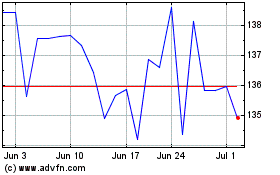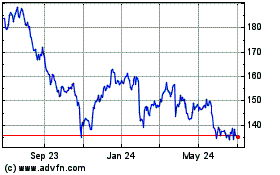By Paul Ziobro and Vipal Monga
United Parcel Service Inc.will freeze pension plans for about
70,000 nonunion employees, seeking to contain the burden of a
retirement fund with a nearly $10 billion deficit.
The package carrier is the latest major U.S. corporation seeking
to corral rising pension obligations, which have swollen after
years of low interest rates. The collective deficit in pension
plans of S&P 1500 companies totaled $408 billion at the end of
last year, according to consulting firm Mercer.
The Atlanta-based company, which is spending billions to expand
its network to handle the surge in e-commerce shipments, said
Tuesday it will freeze pension benefits in five years for nonunion
workers. It will move those individuals to 401(k) accounts and
contribute funds to those retirement plans.
UPS has more than 434,000 workers worldwide, with more than 80%
in the U.S. Most of them are unionized and won't be affected by the
changes. But the move could set up a showdown with the United
Brotherhood of Teamsters, which represents 268,000 UPS workers and
is preparing to negotiate a new contract.
A pension freeze puts UPS in line with a wide swath of American
corporations. In 2014, 37% of Fortune 500 companies with defined
benefit plans had frozen them in some way, compared with 35% with
open plans, according to the consultancy Willis Towers Watson. That
was the first year that frozen plans outpaced all other types,
including closed or terminated. As recently as 2010, half of large
companies with defined benefit plans were open.
UPS is trying to make a dent in a U.S. pension deficit that
reached $9.85 billion at the end of 2016, according to its annual
report. The plans, with $41.07 billion in obligations, were 76%
funded at that point, down from nearly 90% at the end of 2013.
Like most corporate pension sponsors, UPS fell victim to
historically low interest rates. Companies calculate the value of
future benefits based on interest rates. Obligations rise when
rates fall. A precipitous drop in interest rates -- which have
stayed lower for longer than many pension managers expected after
the financial crisis -- helped drive up the shipper's deficit.
While interest rates have pushed up the obligations, UPS helped
compound the problem, by neglecting to add enough to the plan to
make the up the difference. Although the company contributed almost
$5 billion into its fund between 2012 and 2016, it only made
minimum contributions required by law in 2012. In 2013 it put no
money into the plan.
"We have the same challenges here that other companies have,"
said UPS spokesman Steve Gaut, citing a combination of discount
rates, shifting demographics and regulatory changes. "There's
nothing extraordinary for UPS."
UPS's pension struggles mirror broader funding problems among
companies that offer retirement benefits. The median S&P 1500
pension plan's funded status was 76% at the end of 2016, according
to a report by the financial strategies group at Citigroup Inc.
Companies are required by law to close those gaps over time, but
the deficits have persisted, even though S&P 1500 firms
collectively have contributed more than $550 billion into the plans
from 2008 to 2016.
The ongoing cash drain is encouraging more executives to look
for ways to stem the bleeding. "This costs a lot of cash, and the
cash hasn't resulted in a better funded status," said Jason
Richards, pension risk consultant at Willis Towers Watson.
Companies that freeze their pensions can later offer lump-sum
payouts to active employees and potentially spin them off entirely
to third parties, he explained. Those options aren't available to
plans that continue to accrue obligations to workers.
General Motors Co., Verizon Communications Inc. and others have
sold large pension obligations to insurers in recent years, as part
of a multistep process that included freezing pension plans.
Earlier this week, financial-services firm The Hartford offloaded
$1.6 billion of its pension to Prudential Financial Inc.
UPS said its pension freeze will go into effect on Jan. 1, 2023
for affected employees, meaning they no longer accrue additional
benefit for future service. The company had closed the pension plan
to new hires in July 2016.
Under the new program, UPS will contribute 5% to 8% of
employees' annual compensation to their 401(k) accounts and match
up to 3% of employee contributions. "It's a fairly generous program
we're moving to despite freezing the defined benefit plan," Mr.
Gaut said.
UPS declined to say whether it would seek a similar concession
from union members. "It's way too premature to talk about anything
relating to our future collective bargaining discussions," Mr. Gaut
said.
Teamsters spokesman Galen Munroe declined to comment.
Last year, UPS offered buyouts to all former UPS employees who
were vested in the pension plan. Around 22,000 accepted the deal,
accelerating $685 million in pension benefits that were due last
year.
Write to Paul Ziobro at Paul.Ziobro@wsj.com and Vipal Monga at
vipal.monga@wsj.com
(END) Dow Jones Newswires
June 27, 2017 18:34 ET (22:34 GMT)
Copyright (c) 2017 Dow Jones & Company, Inc.
United Parcel Service (NYSE:UPS)
Historical Stock Chart
From Mar 2024 to Apr 2024

United Parcel Service (NYSE:UPS)
Historical Stock Chart
From Apr 2023 to Apr 2024
